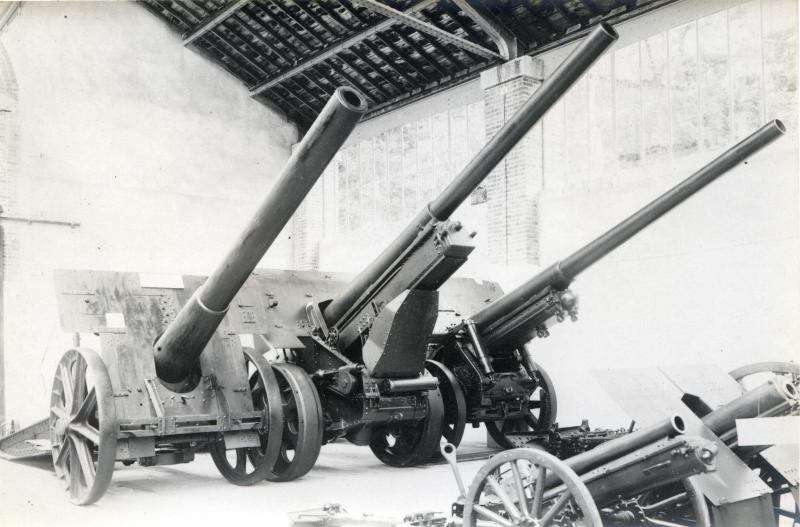
L-R s.15-cm SKL/40 i.R, 15-cm K.16 Krupp et 15-cm K.16 Rheinmetall au Musée de l’Artillerie de l’École de Fontainebleau.
Both these pictures Krupp model.
The inclusion of a gun with a calibre of only 150 mm (5.9 in) may seem out of place in a description of heavy artillery, but the German 15-cm (5,9-in) guns were really in a class above that of normal field artillery, Quite apart from their size and weight, they were intended for use as corps artillery capable of long-range counter-battery and ‘interdiction’ employment, and thus came into the heavy artillery category.
By 1916 the long-range German artillery in use on the
Western Front was mainly of a makeshift nature, being derived from a policy of
placing coastal defence or naval gun barrels on to improvised field carriages.
While this was adequate as a stopgap measure, the gunners needed something more
suitable and manageable for their long-term equipment, and consequently the
German general staff made a special plea to its artillery designers for a
world-beater. Both Krupp and Rheinmetall took up the challenge, and as things
turned out their individual submissions were virtually identical. Both guns
were named 15-cm Kanone 16 or 15-cm K 16, but in the long term it was the Krupp
15-cm K 16 Kp submission that was produced in the greater quantities, The
Rheinmetall 15-cm K 16 Rh was produced in some numbers as the demands from the front
were so great, but never in the numbers that Krupp was able to churn out.
The 15-cm K 16 was along and large gun, The overall design
was entirely orthodox for the time apart from the fact that the barrel was
extraordinarily long (L/42.7 in the Krupp design and L/42.9 in the Rheinmetall
offering) for the size of the wheeled carriage. The carriage was a fairly
simple box-trail design fitted with a large shield for the gun crew, Heavy
spoked wheels were fitted as the gun had to be towed by horse teams as motor
traction was by that stage of the war (it was 1917 before appreciable numbers
of the guns actually reached the front) at a premium and resewed mainly for the
really heavy guns, The weights involved meant that the 15-cm K 16 had to be towed
in two loads, the barrel and the carriage. The carriage was usually towed on a
special four-wheeled limber which also had some seating for the crew members,
who also operated the brakes,
On the Western Front the 15-cm K 16 became one of the most feared of all the German counter-battery guns. The long range (22000 m/24,060 yards) of the gun meant that it could reach well into the rear areas behind the Allied lines to destroy gun batteries, road and rail junctions and generally to lay down harassing fire that could not be countered by anything other than the heaviest and longest-ranged Allied guns (railway artillery or specially emplaced weapons). This entailed a great deal of effort on the part of the Allies, for despite its weight and bulk, the 15-cm K 16 was still more mobile than its potential opposition.
After 1918 numbers of 15-cm K 16s were handed out to various nations as war reparations (Belgium was a major recipient) but the gun was one of the few allowed to remain on the strength of the small post-Versailles German army. Thus for nearly two decades it acted as a training weapon for a new generation of gunners who, reequipped and with a new military philosophy, went to war once again. Even then the 15-cm K 16 was used during some of the early World War II campaigns.
SPECIFICATION
Calibre: 150mm/5.91in.
Length of gun: 6410mm/252.36in/21.03ft.
Length of bore: not known.
Rifling: right-hand uniform twist, 1/25.
Breech mechanism: horizontal sliding block, percussion
fired.
Traverse: 8°.
Elevation: ‒3° to +43°.
Weight in action: 10870kg/23968lb/10.70ton.
Performance
Firing the standard high explosive shell weighing
51.40kg(113.34lb).
Charge 1: velocity 555mps/1821fps, range figures not
available.
Charge 2: velocity 696mps/2284fps, range figures not
available.
Charge 3: velocity 757mps/2485fps, maximum range
22000m/24059yd.
Ammunition
Separate-loading, cased charge.
Projectiles
15cm Hbgr 16: fuzed Hbgr Z 17/23, weight 51.40kg(l 13.34lb).
This was a nose-fuzed high explosive shell with a ballistic
cap. The fuze, a modified First World War model, was only used with this
equipment.
15cm Hbgr 16 umg: fuzed AZ Hbgr or Dopp Z S/60, weight
51.40kg(113.34lb)
This, basically similar to the previous shell, differed in
the fuze-hole gauge and was thus adapted to the use of newer patterns of fuze.
Propelling Charges
A three-part charge of tubular propellant was provided in
three bags. The charge 1 bag was issued in the cartridge case, the charge 2 bag
replaced it completely when needed and the charge 3 bag could be slipped into
the case alongside the charge 2 bag. A small circular igniter pad was secured
to the bottom of the case by shellac cement.
Charge 1: 6.65kg/14.65lb Ngl R P.
Charge 2: 11.08kg/24.43lb Ngl R P
Charge 3: 1.04kg/2.29lb Ngl R P.
Primer
The percussion primer C/12nA was used.
Case Identification Number: 6304.